How Socially Avoidant Emerging Adults Process Social Feedback during Human-to-Human Interaction after Social Rejection: An Event-Related Potential Study
Abstract
:1. Introduction
1.1. Social Avoidance and Interpersonal Interaction
1.2. Social Rejection
1.3. ERP and Social Feedback
1.4. Present Study
2. Materials and Methods
2.1. Participants
2.2. Measures
2.3. Procedure
2.3.1. Social Rejection Paradigms
2.3.2. Computer Game Tasks
2.4. EEG Recording and Data Analysis
3. Results
3.1. N1 (100–170 ms, Fz)
3.2. FRN (210–280 ms, Fz)
3.3. P300 (300–410 ms, Fz)
3.4. RewP (250–350 ms, Cz)
4. Discussion
4.1. Insensitivity towards Positive Social Feedback of Socially Avoidant Individuals
4.2. High Sensitivity towards Social Rejection of Socially Avoidant Individuals
4.3. The Impact of Social Rejection
4.4. The Emphasis on the Failure Feedback
4.5. Research Contributions
4.6. Limitations and Future Directions
5. Conclusions
Author Contributions
Funding
Institutional Review Board Statement
Informed Consent Statement
Data Availability Statement
Acknowledgments
Conflicts of Interest
Appendix A
Appendix A.1. Behavioral Results
Appendix A.1.1. RTs
Appendix A.1.2. Successful Rate
| Condition | Task | Feedback | Socially Avoidant Group (n = 16) | Comparison Group (n = 16) | t | p | d | 95% CI | ||||
|---|---|---|---|---|---|---|---|---|---|---|---|---|
| M | SD | M | SD | |||||||||
| Average RTs (ms) | Social rejection | Cooperation | Success | 341.76 | 139.71 | 364.80 | 153.10 | −0.45 | 0.660 | 0.16 | −128.87 | 82.78 |
| Failure | 351.81 | 95.98 | 376.90 | 109.07 | −0.69 | 0.495 | 0.24 | −99.27 | 49.09 | |||
| Competition | Success | 218.18 | 45.37 | 211.84 | 32.75 | 0.45 | 0.654 | 0.16 | −22.23 | 34.91 | ||
| Failure | 345.73 | 139.03 | 296.10 | 46.86 | 1.35 | 0.186 | 0.48 | −25.28 | 124.53 | |||
| Control | Cooperation | Success | 301.52 | 102.84 | 312.46 | 108.50 | −0.29 | 0.772 | 0.10 | −87.27 | 65.38 | |
| Failure | 350.12 | 99.04 | 363.49 | 144.44 | −0.31 | 0.762 | 0.11 | −102.78 | 76.05 | |||
| Competition | Success | 221.32 | 27.53 | 215.87 | 30.78 | 0.53 | 0.601 | 0.19 | −15.63 | 26.54 | ||
| Failure | 331.37 | 89.19 | 307.44 | 85.09 | 0.78 | 0.443 | 0.27 | −39.00 | 86.88 | |||
| Successful rate (%) | Social rejection | Cooperation | 52.81 | 17.31 | 52.53 | 17.44 | 0.05 | 0.965 | 0.02 | −12.27 | 12.82 | |
| Competition | 57.99 | 12.27 | 42.55 | 12.64 | 3.51 | 0.001 | 1.24 | 6.45 | 24.43 | |||
| Control | Cooperation | 58.94 | 11.77 | 59.15 | 11.30 | −0.05 | 0.959 | 0.02 | −8.54 | 8.12 | ||
| Competition | 52.52 | 12.67 | 48.19 | 12.88 | 0.96 | 0.346 | 0.34 | −4.90 | 13.55 | |||
Appendix B
References
- Chan, S.; Rawana, J.S. Examining the associations between interpersonal emotion regulation and psychosocial adjustment in emerging adulthood. Cogn. Ther. Res. 2021, 45, 652–662. [Google Scholar] [CrossRef]
- Rubin, K.H.; Coplan, R.J.; Bowker, J.C. Social Withdrawal in Childhood. Annu. Rev. Psychol. 2009, 60, 141–171. [Google Scholar] [CrossRef] [PubMed]
- Nelson, L.J. Going It Alone: Comparing Subtypes of Withdrawal on Indices of Adjustment and Maladjustment in Emerging Adulthood. Rev. Soc. Dev. 2013, 22, 522–538. [Google Scholar] [CrossRef]
- Nikitin, J.; Freund, A.M. Who Cares? Effects of Social Approach and Avoidance Motivation on Responsiveness to Others. Personal. Soc. Psychol. Bull. 2018, 45, 182–195. [Google Scholar] [CrossRef] [PubMed]
- Lundh, L.-G.; Berg, B.; Johansson, H.; Nilsson, L.K.; Sandberg, J.; Segerstedt, A. Social Anxiety is Associated with a Negatively Distorted Perception of One’s Own Voice. Cogn. Behav. Ther. 2002, 31, 25–30. [Google Scholar] [CrossRef]
- van Niekerk, R.E.; Klein, A.M.; Allart-van Dam, E.; Hudson, J.L.; Rinck, M.; Hutschemaekers, G.J.M.; Becker, E.S. The Role of Cognitive Factors in Childhood Social Anxiety: Social Threat Thoughts and Social Skills Perception. Cogn. Ther. Res. 2017, 41, 489–497. [Google Scholar] [CrossRef] [PubMed]
- Gordils, J.; Jamieson, J.P. Fast Foes: The physiological and behavioral consequences of interacting in an immersive negative social context. Anxiety Stress Coping 2021, 34, 320–334. [Google Scholar] [CrossRef]
- Gellner, A.-K.; Voelter, J.; Schmidt, U.; Beins, E.C.; Stein, V.; Philipsen, A.; Hurlemann, R. Molecular and neurocircuitry mechanisms of social avoidance. Cell. Mol. Life Sci. 2021, 78, 1163–1189. [Google Scholar] [CrossRef] [PubMed]
- Drydakis, N. Social Rejection, Family Acceptance, Economic Recession, and Physical and Mental Health of Sexual Minorities. Sex. Res. Soc. Policy 2022, 19, 1318–1340. [Google Scholar] [CrossRef]
- Kwan, Y.; Lee, J.; Hwang, S.; Choi, S. Social Hypersensitivity in Bipolar Disorder: An ERP Study. Eur. Psychiatry 2022, 65, S159. [Google Scholar] [CrossRef]
- Asendorpf, J.B. Beyond Social Withdrawal—Shyness, Unsociability, and Peer Avoidance. Hum. Dev. 1990, 33, 250–259. [Google Scholar] [CrossRef]
- Coplan, R.J.; Armer, M. A “Multitude” of Solitude: A Closer Look at Social Withdrawal and Nonsocial Play in Early Childhood. Child Dev. Perspect. 2007, 1, 26–32. [Google Scholar] [CrossRef]
- Tomova, L.; Andrews, J.L.; Blakemore, S.-J. The importance of belonging and the avoidance of social risk taking in adolescence. Dev. Rev. 2021, 61, 100981. [Google Scholar] [CrossRef]
- Perry, A.; Rubinsten, O.; Peled, L.; Shamay-Tsoory, S.G. Don’t stand so close to me: A behavioral and ERP study of preferred interpersonal distance. Neuroimage 2013, 83, 761–769. [Google Scholar] [CrossRef] [PubMed]
- Cui, L.X.; Dong, X.F.; Zhang, S. ERP evidence for emotional sensitivity in social anxiety. J. Affect. Disord. 2021, 279, 361–367. [Google Scholar] [CrossRef] [PubMed]
- Ellis, A.J.; Salgari, G.; Miklowitz, D.J.; Loo, S.K. The role of avoidance motivation in the relationship between reward sensitivity and depression symptoms in adolescents: An ERP study. Psychiatry Res. 2019, 279, 345–349. [Google Scholar] [CrossRef]
- Markova, G.; Nguyen, T.; Hoehl, S. Neurobehavioral Interpersonal Synchrony in Early Development: The Role of Interactional Rhythms. Front. Psychol. 2019, 10, 474651. [Google Scholar] [CrossRef] [PubMed]
- Kashdan, T.B.; Goodman, F.R.; Machell, K.A.; Kleiman, E.M.; Monfort, S.S.; Ciarrochi, J.; Nezlek, J.B. A Contextual Approach to Experiential Avoidance and Social Anxiety: Evidence from an Experimental Interaction and Daily Interactions of People With Social Anxiety Disorder. Emotion 2014, 14, 769–781. [Google Scholar] [CrossRef] [PubMed]
- Schlund, M.W.; Carter, H.; Cudd, G.; Murphy, K.; Ahmed, N.; Dymond, S.; Tone, E.B. Human social defeat and approach–avoidance: Escalating social-evaluative threat and threat of aggression increases social avoidance. J. Exp. Anal. Behav. 2021, 115, 157–184. [Google Scholar] [CrossRef]
- Decety, J.; Jackson, P.L.; Sommerville, J.A.; Chaminade, T.; Meltzoff, A.N. The neural bases of cooperation and competition: An fMRI investigation. NeuroImage 2004, 23, 744–751. [Google Scholar] [CrossRef]
- Balconi, M.; Vanutelli, M.E. Cooperation and Competition with Hyperscanning Methods: Review and Future Application to Emotion Domain. Front. Comput. Neurosci. 2017, 11, 86. [Google Scholar] [CrossRef]
- Tsoi, L.; Dungan, J.; Waytz, A.; Young, L. Distinct neural patterns of social cognition for cooperation versus competition. NeuroImage 2016, 137, 86–96. [Google Scholar] [CrossRef] [PubMed]
- Yang, H.; Duan, Q.; Peng, M.; Gu, R.; Sun, X. Sex differences on the response to others’ gains and losses under cooperation and competition. Int. J. Psychophysiol. 2022, 182, 211–219. [Google Scholar] [CrossRef]
- Blackhart, G.C.; Nelson, B.C.; Knowles, M.L.; Baumeister, R.F. Rejection Elicits Emotional Reactions but Neither Causes Immediate Distress nor Lowers Self-Esteem: A Meta-Analytic Review of 192 Studies on Social Exclusion. Personal. Soc. Psychol. Rev. 2009, 13, 269–309. [Google Scholar] [CrossRef]
- Williams, K.D.; Cheung, C.K.T.; Choi, W. Cyberostracism: Effects of being ignored over the Internet. J. Personal. Soc. Psychol. 2000, 79, 748–762. [Google Scholar] [CrossRef] [PubMed]
- Leng, Y.; Qian, X.; Zhu, Y.M. Modulation of brain response to peer rejection by rejection sensitivity: An exploratory study. Neuropsychologia 2018, 117, 389–397. [Google Scholar] [CrossRef] [PubMed]
- Pegg, S.; Lytle, M.N.; Arfer, K.B.; Kujawa, A. The time course of reactivity to social acceptance and rejection feedback: An examination of event-related potentials and behavioral measures in a peer interaction task. Psychophysiology 2022, 59, e14007. [Google Scholar] [CrossRef]
- Richman, L.S.; Leary, M.R. Reactions to Discrimination, Stigmatization, Ostracism, and Other Forms of Interpersonal Rejection: A Multimotive Model. Psychol. Rev. 2009, 116, 365–383. [Google Scholar] [CrossRef] [PubMed]
- Petereit, P.; Jessen, S.; Fjaellingsdal, T.G.; Kramer, U.M. Social Context and Rejection Expectations Modulate Neural and Behavioral Responses to Social Feedback. J. Cogn. Neurosci. 2022, 34, 823–845. [Google Scholar] [CrossRef]
- White, L.O.; Wu, J.; Borelli, J.L.; Rutherford, H.J.V.; David, D.H.; Kim-Cohen, J.; Mayes, L.C.; Crowley, M.J. Attachment Dismissal Predicts Frontal Slow-Wave ERPs During Rejection by Unfamiliar Peers. Emotion 2012, 12, 690–700. [Google Scholar] [CrossRef]
- Hinz, N.-A.; Ciardo, F.; Wykowska, A. ERP markers of action planning and outcome monitoring in human—Robot interaction. Acta Psychol. 2021, 212, 103216. [Google Scholar] [CrossRef] [PubMed]
- Kujawa, A.; Kessel, E.M.; Carroll, A.; Arfer, K.B.; Klein, D.N. Social processing in early adolescence: Associations between neurophysiological, self-report, and behavioral measures. Biol. Psychol. 2017, 128, 55–62. [Google Scholar] [CrossRef] [PubMed]
- Babinski, D.E.; Pegg, S.; West, M.; Arfer, K.B.; Kujawa, A. Borderline personality features and altered social feedback processing in emerging adults: An EEG study. Prog. Neuro-Psychopharmacol. Biol. Psychiatry 2023, 120, 110648. [Google Scholar] [CrossRef]
- Severo, M.C.; Paul, K.; Walentowska, W.; Moors, A.; Pourtois, G. Neurophysiological evidence for evaluative feedback processing depending on goal relevance. NeuroImage 2020, 215, 116857. [Google Scholar] [CrossRef] [PubMed]
- Lin, T.; Zhang, X.; Fields, E.C.; Sekuler, R.; Gutchess, A. Spatial frequency impacts perceptual and attentional ERP components across cultures. Brain Cogn. 2022, 157, 105834. [Google Scholar] [CrossRef] [PubMed]
- Pourtois, G.; De Pretto, M.; Hauert, C.-A.; Vuilleumier, P. Time Course of Brain Activity during Change Blindness and Change Awareness: Performance is Predicted by Neural Events before Change Onset. J. Cogn. Neurosci. 2006, 18, 2108–2129. [Google Scholar] [CrossRef] [PubMed]
- Ibanez, A.; Melloni, M.; Huepe, D.; Helgiu, E.; Rivera-Rei, A.; Canales-Johnson, A.; Baker, P.; Moya, A. What event-related potentials (ERPs) bring to social neuroscience? Soc. Neurosci. 2012, 7, 632–649. [Google Scholar] [CrossRef]
- Bolis, D.; Dumas, G.; Schilbach, L. Interpersonal attunement in social interactions: From collective psychophysiology to inter-personalized psychiatry and beyond. Philos. Trans. R. Soc. B Biol. Sci. 2023, 378, 20210365. [Google Scholar] [CrossRef]
- Chen, Z.; Williams, K.D.; Fitness, J.; Newton, N.C. When Hurt Will Not Heal: Exploring the Capacity to Relive Social and Physical Pain. Psychol. Sci. 2008, 19, 789–795. [Google Scholar] [CrossRef]
- Eisenberger, N.I.; Lieberman, M.D. Why rejection hurts: A common neural alarm system for physical and social pain. Trends Cogn. Sci. 2004, 8, 294–300. [Google Scholar] [CrossRef]
- Eisenberger, N.I.; Lieberman, M.D.; Williams, K.D. Does rejection hurt? An fMRI study of social exclusion. Science 2003, 302, 290–292. [Google Scholar] [CrossRef] [PubMed]
- Faul, F.; Erdfelder, E.; Lang, A.-G.; Buchner, A. G*Power 3: A flexible statistical power analysis program for the social, behavioral, and biomedical sciences. Behav. Res. Methods 2007, 39, 175–191. [Google Scholar] [CrossRef] [PubMed]
- Schwab, D.; Schienle, A. Facial emotion processing in pediatric social anxiety disorder: Relevance of situational context. J. Anxiety Disord. 2017, 50, 40–46. [Google Scholar] [CrossRef] [PubMed]
- Bowker, J.C.; Raja, R. Social Withdrawal Subtypes during Early Adolescence in India. J. Abnorm. Child Psychol. 2011, 39, 201–212. [Google Scholar] [CrossRef] [PubMed]
- Eggum-Wilkens, N.D.; An, D.; Zhang, L.; Costa, M. Co-occurrence of and cross-informant agreement on shyness, unsociability, and social avoidance during early adolescence. Soc. Dev. 2020, 29, 73–88. [Google Scholar] [CrossRef]
- Freedman, G.; Williams, K.D.; Beer, J.S. Softening the Blow of Social Exclusion: The Responsive Theory of Social Exclusion. Front. Psychol. 2016, 7, 213328. [Google Scholar] [CrossRef]
- Somerville, L.H.; Kelley, W.M.; Heatherton, T.F. Self-esteem Modulates Medial Prefrontal Cortical Responses to Evaluative Social Feedback. Cereb. Cortex 2010, 20, 3005–3013. [Google Scholar] [CrossRef]
- Brennan, G.M.; Crowley, M.J.; Wu, J.; Mayes, L.C.; Baskin-Sommers, A.R. Neural processing of social exclusion in individuals with psychopathic traits: Links to anger and aggression. Psychiatry Res. 2018, 268, 263–271. [Google Scholar] [CrossRef] [PubMed]
- Zheng, Z.; Li, S.; Mo, L.; Chen, W.; Zhang, D. ISIEA: An image database of social inclusion and exclusion in young Asian adults. Behav. Res. Methods 2022, 54, 2409–2421. [Google Scholar] [CrossRef]
- Cui, X.; Bryant, D.M.; Reiss, A.L. NIRS-based hyperscanning reveals increased interpersonal coherence in superior frontal cortex during cooperation. NeuroImage 2012, 59, 2430–2437. [Google Scholar] [CrossRef]
- Rivera, B.; Soylu, F. Incongruity in fraction verification elicits N270 and P300 ERP effects. Neuropsychologia 2021, 161, 108015. [Google Scholar] [CrossRef] [PubMed]
- Proudfit, G.H. The reward positivity: From basic research on reward to a biomarker for depression. Psychophysiology 2015, 52, 449–459. [Google Scholar] [CrossRef] [PubMed]
- Closson, L.M.; McVarnock, A.; Sanford, K. Social Withdrawal and Social Surrogacy in Emerging Adulthood. J. Youth Adolesc. 2019, 48, 717–730. [Google Scholar] [CrossRef] [PubMed]
- Nelson, L.J.; Coyne, S.M.; Howard, E.; Clifford, B.N. Withdrawing to a Virtual World: Associations between Subtypes of Withdrawal, Media Use, and Maladjustment in Emerging Adults. Dev. Psychol. 2016, 52, 933–942. [Google Scholar] [CrossRef]
- Schindler, S.; Kissler, J. Language-based social feedback processing with randomized “senders”: An ERP study. Soc. Neurosci. 2018, 13, 202–213. [Google Scholar] [CrossRef]
- Fernández-Theoduloz, G.; Paz, V.; Nicolaisen-Sobesky, E.; Pérez, A.; Buunk, A.P.; Cabana, A.; Gradin, V.B. Social Avoidance in Depression: A Study Using a Social Decision-Making Task. J. Abnorm. Psychol. 2019, 128, 234–244. [Google Scholar] [CrossRef]
- Vogel, E.K.; Luck, S.J. The visual N1 component as an index of a discrimination process. Psychophysiology 2000, 37, 190–203. [Google Scholar] [CrossRef]
- Cui, F.; Zhu, X.; Duan, F.; Luo, Y. Instructions of cooperation and competition influence the neural responses to others’ pain: An ERP study. Soc. Neurosci. 2016, 11, 289–296. [Google Scholar] [CrossRef]
- Sun, S.; Yu, R. The feedback related negativity encodes both social rejection and explicit social expectancy violation. Front. Hum. Neurosci. 2014, 8, 556. [Google Scholar] [CrossRef]
- Nieuwenhuis, S.; Holroyd, C.B.; Mol, N.; Coles, M.G.H. Reinforcement-related brain potentials from medial frontal cortex: Origins and functional significance. Neurosci. Biobehav. Rev. 2004, 28, 441–448. [Google Scholar] [CrossRef]
- Wesselmann, E.D.; Williams, K.D. Social life and social death: Inclusion, ostracism, and rejection in groups. Group Process. Intergroup Relat. 2017, 20, 693–706. [Google Scholar] [CrossRef]
- Dyson, B.J.; Steward, B.A.; Meneghetti, T.; Forder, L. Behavioural and neural limits in competitive decision making: The roles of outcome, opponency and observation. Biol. Psychol. 2020, 149, 107778. [Google Scholar] [CrossRef] [PubMed]
- Kessler, L.; Hewig, J.; Weichold, K.; Silbereisen, R.K.; Miltner, W.H.R. Feedback negativity and decision-making behavior in the Balloon Analogue Risk Task (BART) in adolescents is modulated by peer presence. Psychophysiology 2017, 54, 260–269. [Google Scholar] [CrossRef] [PubMed]
- Miles, L.K.; Griffiths, J.L.; Richardson, M.J.; Macrae, C.N. Too late to coordinate: Contextual influences on behavioral synchrony. Eur. J. Soc. Psychol. 2010, 40, 52–60. [Google Scholar] [CrossRef]
- Li, Y.; Chen, M.; Zhang, R.; Li, X. Experiencing happiness together facilitates dyadic coordination through the enhanced interpersonal neural synchronization. Soc. Cogn. Affect. Neurosci. 2021, 17, 447–460. [Google Scholar] [CrossRef] [PubMed]
- Reindl, V.; Gerloff, C.; Scharke, W.; Konrad, K. Brain-to-brain synchrony in parent-child dyads and the relationship with emotion regulation revealed by fNIRS-based hyperscanning. NeuroImage 2018, 178, 493–502. [Google Scholar] [CrossRef] [PubMed]
- Liu, T.; Pelowski, M. A new research trend in social neuroscience: Towards an interactive-brain neuroscience. PsyCh J. 2014, 3, 177–188. [Google Scholar] [CrossRef] [PubMed]
- Caruana, N.; McArthur, G.; Woolgar, A.; Brock, J. Simulating social interactions for the experimental investigation of joint attention. Neurosci. Biobehav. Rev. 2017, 74, 115–125. [Google Scholar] [CrossRef]
- Bowker, J.C.; Bowker, M.H.; Santo, J.B.; Ojo, A.A.; Etkin, R.G.; Raja, R. Severe Social Withdrawal: Cultural Variation in Past Hikikomori Experiences of University Students in Nigeria, Singapore, and the United States. J. Genet. Psychol. 2019, 180, 217–230. [Google Scholar] [CrossRef]
- Babiloni, F.; Astolfi, L. Social neuroscience and hyperscanning techniques: Past, present and future. Neurosci. Biobehav. Rev. 2014, 44, 76–93. [Google Scholar] [CrossRef]
- Valt, C.; Sprengeler, M.K.; Stürmer, B. Feedback processing in the context of social comparison. Psychophysiology 2020, 57, e13489. [Google Scholar] [CrossRef] [PubMed]
- Gazelle, H. Two Models of the Development of Social Withdrawal and Social Anxiety in Childhood and Adolescence: Progress and Blind Spots. Children 2022, 9, 734. [Google Scholar] [CrossRef] [PubMed]
- Yuan, Y.; Jiang, S.; Wen, X.; Han, Z.; Wu, D.; Wang, X.; Ye, T.; Hu, Y.; Jeong, J.; Xiang, M. The Chain-Mediation Pathway of Social Avoidance to Depression in College Students Is Regulated by Self-Esteem. Front. Psychol. 2022, 13, 802161. [Google Scholar] [CrossRef] [PubMed]
- Terzian, E.; Tognoni, G.; Bracco, R.; De Ruggieri, E.; Ficociello, R.A.; Mezzina, R.; Pillo, G. Social Network Intervention in Patients with Schizophrenia and Marked Social Withdrawal: A Randomized Controlled Study. Can. J. Psychiatry 2013, 58, 622–631. [Google Scholar] [CrossRef]
- Chen, X.; Xu, X.; Liu, A.; Lee, S.; Chen, X.; Zhang, X.; McKeown, M.J.; Wang, Z.J. Removal of Muscle Artifacts From the EEG: A Review and Recommendations. IEEE Sens. J. 2019, 19, 5353–5368. [Google Scholar] [CrossRef]
- Li, R.; Yang, D.; Fang, F.; Hong, K.-S.; Reiss, A.L.; Zhang, Y. Concurrent fNIRS and EEG for Brain Function Investigation: A Systematic, Methodology-Focused Review. Sensors 2022, 22, 5865. [Google Scholar] [CrossRef] [PubMed]
- La Greca, A.M.; Dandes, S.K.; Wick, P.; Shaw, K.; Stone, W.L. Development of the Social Anxiety Scale for Children: Reliability and Concurrent Validity. J. Clin. Child Psychol. 1988, 17, 84–91. [Google Scholar] [CrossRef]
- Watson, D.; Clark, L.A.; Tellegen, A. Development and validation of brief measures of positive and negative affect: The PANAS scales. J. Personal. Soc. Psychol. 1988, 54, 1063–1070. [Google Scholar] [CrossRef]
- Cheung, S.-K.; Sun, S.Y.K. Assessment of Optimistic Self-Beliefs: Further Validation of the Chinese Version of the General Self-Efficacy Scale. Psychol. Rep. 1999, 85, 1221–1224. [Google Scholar] [CrossRef]
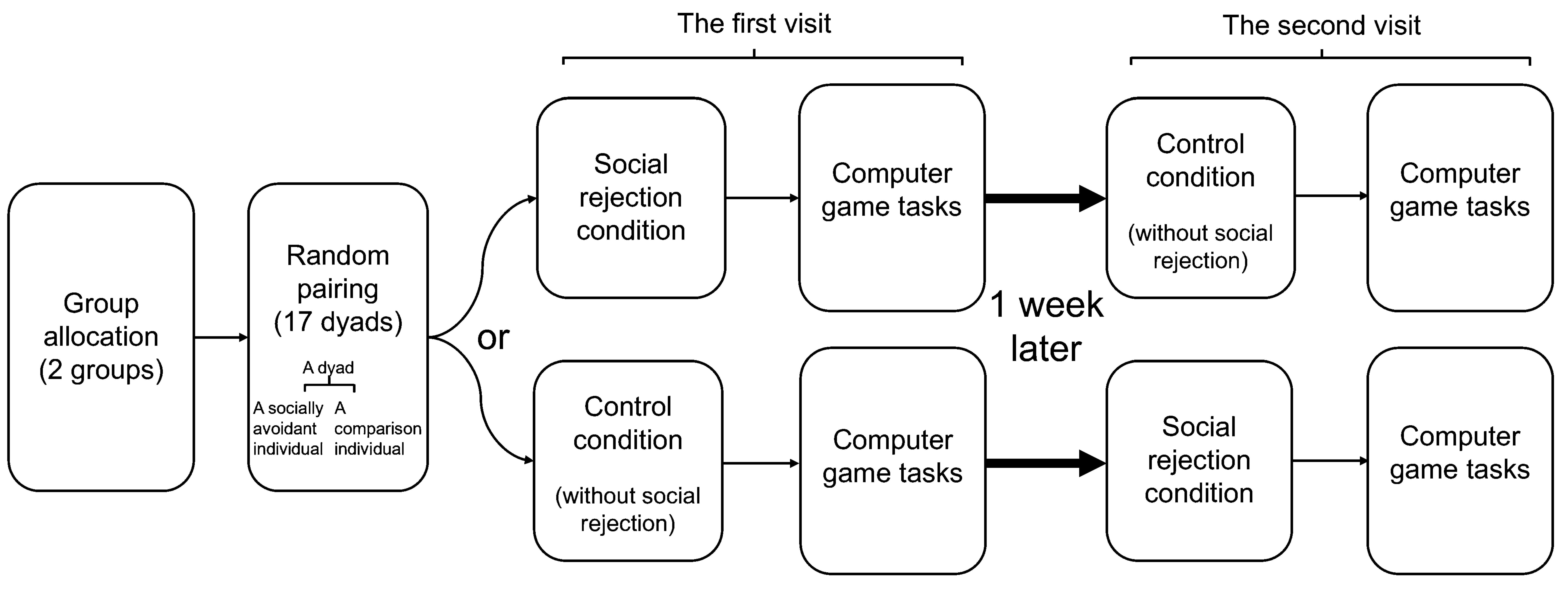

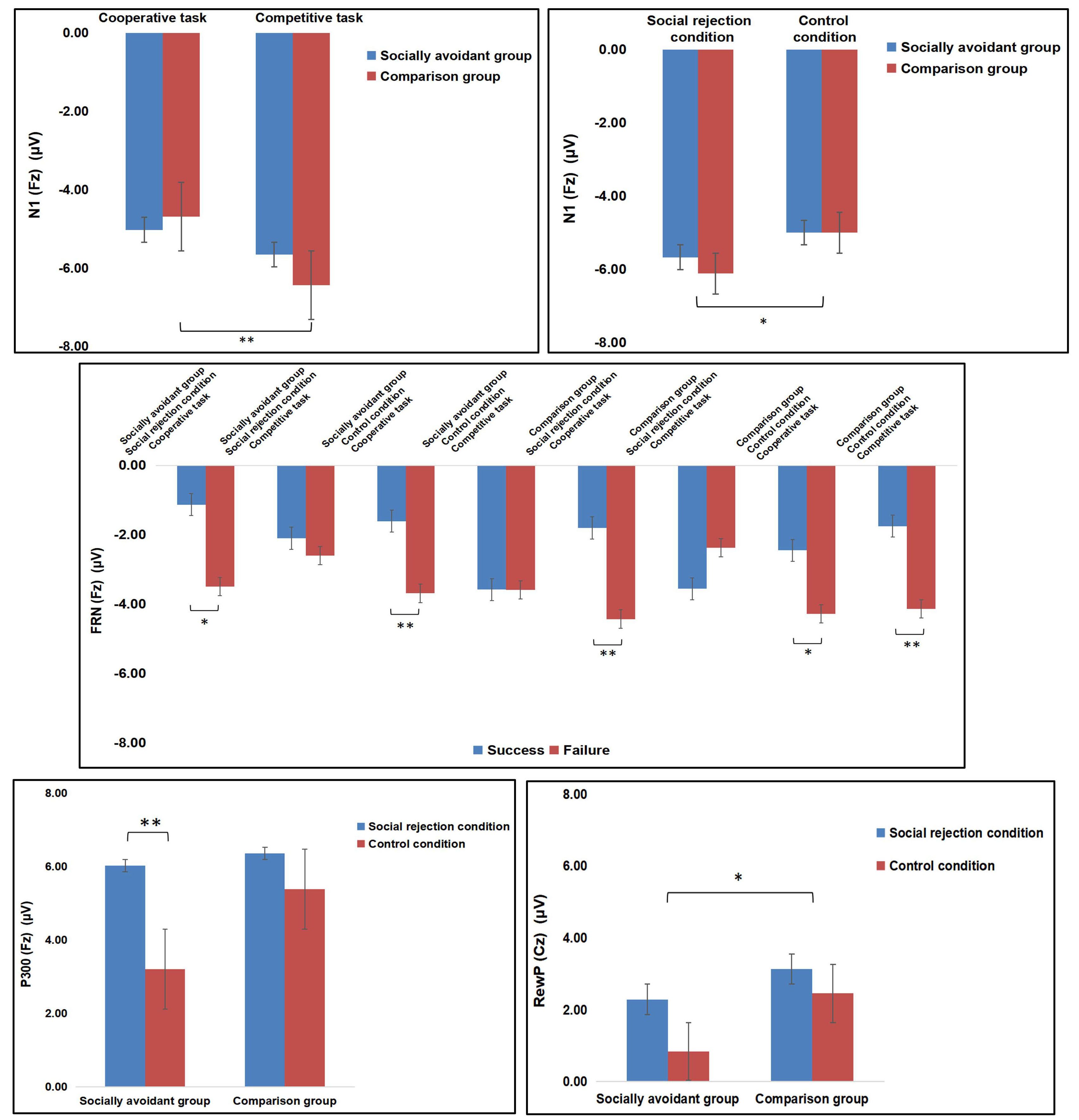
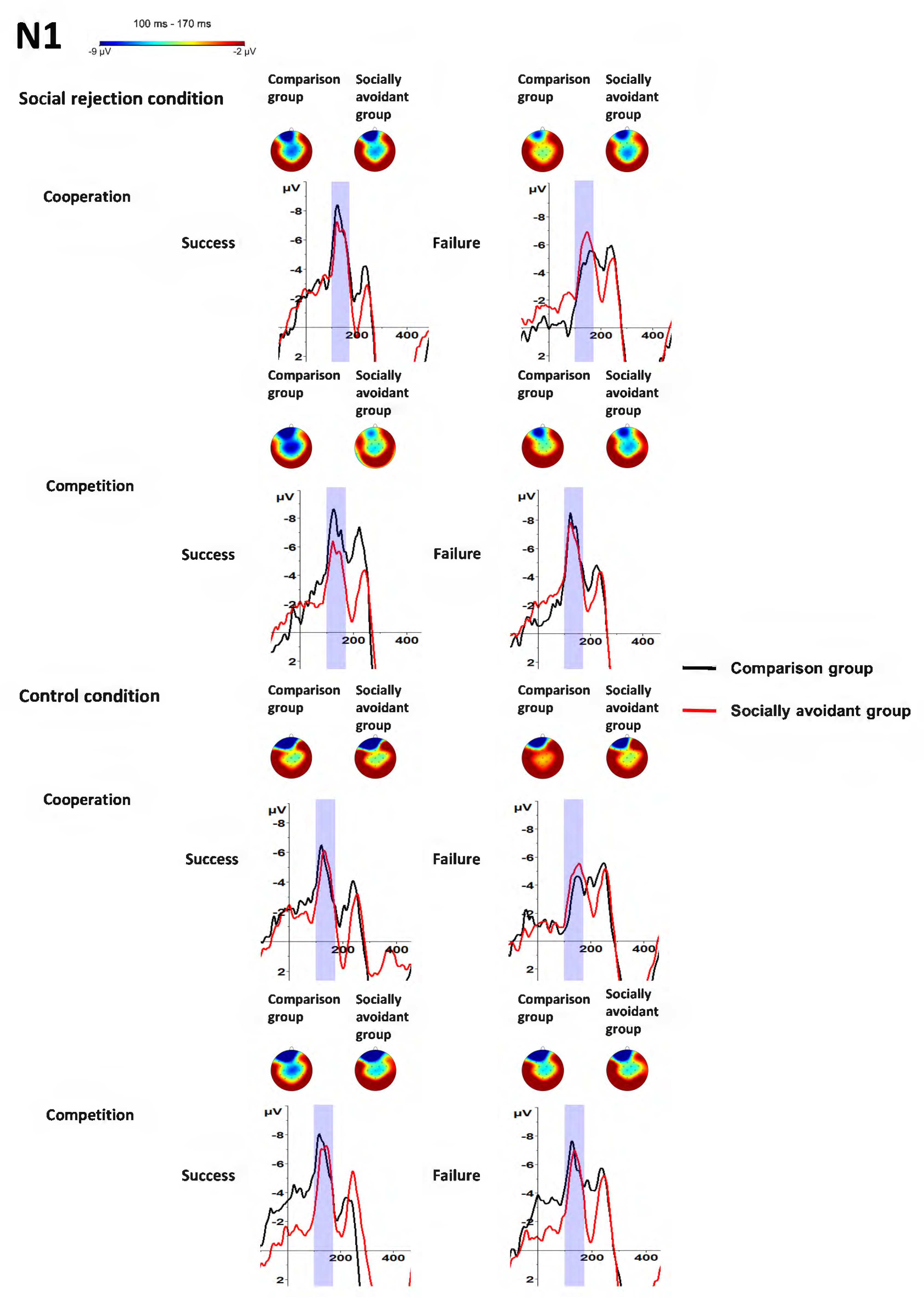
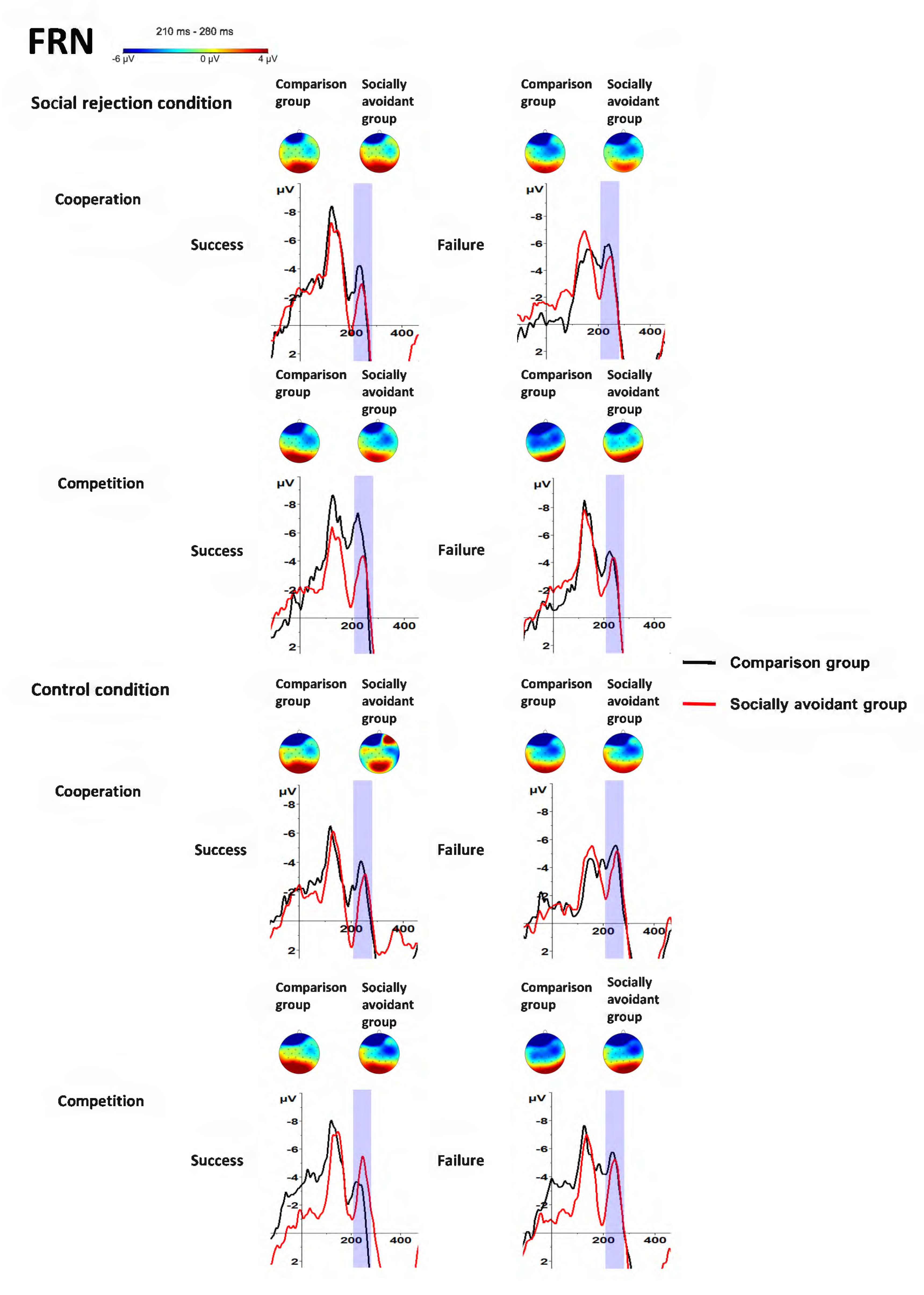
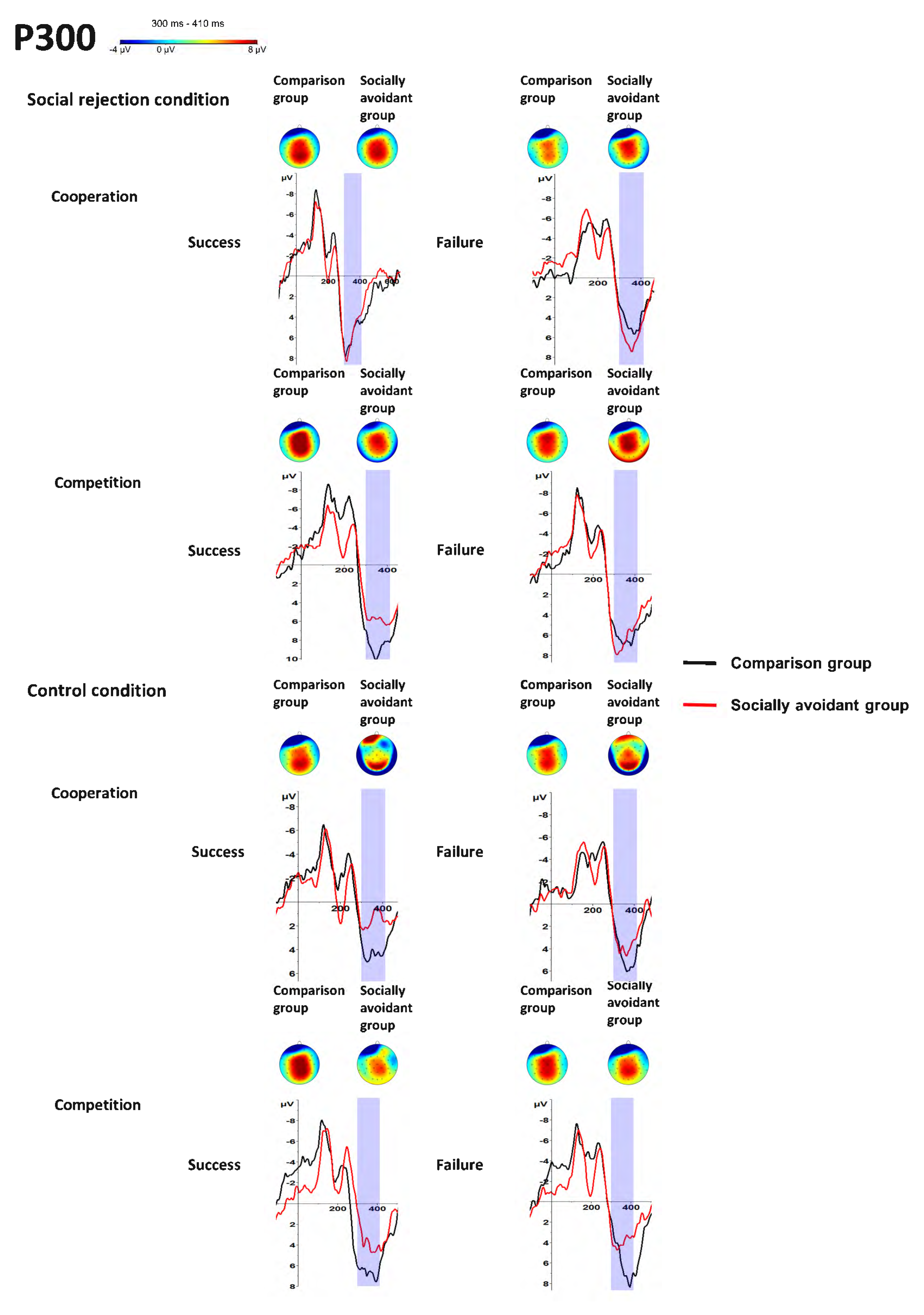

| Component | Condition | Feedback | Socially Avoidant Group (n = 16) | Comparison Group (n = 16) | t | p | d | 95% CI | |||
|---|---|---|---|---|---|---|---|---|---|---|---|
| M | SD | M | SD | ||||||||
| N1 | Social rejection | Cooperative success | −5.93 | 3.29 | −6.73 | 1.67 | 0.87 | 0.392 | 0.31 | −1.08 | 2.69 |
| Cooperative failure | −5.37 | 3.30 | −4.20 | 2.68 | −1.10 | 0.281 | 0.39 | −3.34 | 1.00 | ||
| Competitive success | −6.24 | 2.81 | −7.03 | 2.79 | 0.80 | 0.431 | 0.28 | −1.23 | 2.81 | ||
| Competitive failure | −5.17 | 2.81 | −6.51 | 2.85 | 1.35 | 0.189 | 0.48 | −0.70 | 3.39 | ||
| Control | Cooperative success | −4.55 | 3.30 | −4.66 | 1.70 | 0.12 | 0.903 | 0.04 | −1.81 | 2.04 | |
| Cooperative failure | −4.25 | 2.93 | −3.15 | 2.40 | −1.17 | 0.251 | 0.41 | −3.04 | 0.82 | ||
| Competitive success | −5.36 | 5.01 | −6.29 | 2.15 | 0.68 | 0.505 | 0.24 | −1.92 | 3.77 | ||
| Competitive failure | −5.85 | 3.34 | −5.92 | 2.42 | 0.07 | 0.943 | 0.03 | −2.03 | 2.18 | ||
| FRN | Social rejection | Cooperative success | −1.13 | 3.53 | −1.80 | 4.65 | 0.46 | 0.649 | 0.16 | −2.31 | 3.65 |
| Cooperative failure | −3.49 | 4.25 | −4.43 | 3.03 | 0.72 | 0.477 | 0.25 | −1.73 | 3.60 | ||
| Competitive success | −2.10 | 3.15 | −3.56 | 3.60 | 1.22 | 0.233 | 0.43 | −0.99 | 3.90 | ||
| Competitive failure | −2.60 | 3.40 | −2.37 | 2.52 | −0.21 | 0.832 | 0.08 | −2.39 | 1.93 | ||
| Control | Cooperative success | −1.61 | 3.62 | −2.45 | 4.24 | 0.60 | 0.551 | 0.21 | −2.01 | 3.69 | |
| Cooperative failure | −3.69 | 3.58 | −4.28 | 3.21 | 0.49 | 0.626 | 0.17 | −1.86 | 3.05 | ||
| Competitive success | −3.58 | 4.52 | −1.75 | 3.47 | −1.28 | 0.210 | 0.45 | −4.74 | 1.08 | ||
| Competitive failure | −3.59 | 4.01 | −4.14 | 1.37 | 0.52 | 0.613 | 0.18 | −1.68 | 2.77 | ||
| P300 | Social rejection | Cooperative success | 5.81 | 4.19 | 5.82 | 3.45 | −0.01 | 0.990 | 0.01 | −2.79 | 2.75 |
| Cooperative failure | 5.97 | 5.00 | 4.52 | 3.08 | 0.99 | 0.333 | 0.35 | −1.57 | 4.47 | ||
| Competitive success | 6.47 | 3.68 | 8.75 | 3.91 | −1.70 | 0.099 | 0.60 | −5.03 | 0.46 | ||
| Competitive failure | 5.87 | 4.63 | 6.34 | 4.79 | −0.29 | 0.777 | 0.10 | −3.88 | 2.93 | ||
| Control | Cooperative success | 1.46 | 3.56 | 4.44 | 2.76 | −2.64 | 0.013 | 0.93 | −5.27 | −0.67 | |
| Cooperative failure | 3.73 | 4.90 | 4.65 | 3.94 | −0.59 | 0.560 | 0.21 | −4.14 | 2.28 | ||
| Competitive success | 3.97 | 3.97 | 6.69 | 3.25 | −2.12 | 0.043 | 0.75 | −5.34 | −0.10 | ||
| Competitive failure | 3.643 | 4.71 | 5.74 | 3.15 | −1.48 | 0.149 | 0.52 | −4.99 | 0.79 | ||
| RewP | Social rejection | Cooperation | 2.98 | 2.37 | 3.83 | 2.16 | −1.06 | 0.298 | 0.37 | −2.48 | 0.79 |
| Competition | 1.60 | 2.83 | 2.45 | 2.87 | −0.84 | 0.410 | 0.30 | −2.90 | 1.22 | ||
| Control | Cooperation | 0.20 | 2.96 | 1.52 | 2.89 | −1.28 | 0.210 | 0.45 | −3.43 | 0.79 | |
| Competition | 1.50 | 2.85 | 3.39 | 3.94 | −1.56 | 0.131 | 0.55 | −4.37 | 0.59 | ||
Disclaimer/Publisher’s Note: The statements, opinions and data contained in all publications are solely those of the individual author(s) and contributor(s) and not of MDPI and/or the editor(s). MDPI and/or the editor(s) disclaim responsibility for any injury to people or property resulting from any ideas, methods, instructions or products referred to in the content. |
© 2024 by the authors. Licensee MDPI, Basel, Switzerland. This article is an open access article distributed under the terms and conditions of the Creative Commons Attribution (CC BY) license (https://creativecommons.org/licenses/by/4.0/).
Share and Cite
Chen, Y.; Deng, X. How Socially Avoidant Emerging Adults Process Social Feedback during Human-to-Human Interaction after Social Rejection: An Event-Related Potential Study. Behav. Sci. 2024, 14, 457. https://doi.org/10.3390/bs14060457
Chen Y, Deng X. How Socially Avoidant Emerging Adults Process Social Feedback during Human-to-Human Interaction after Social Rejection: An Event-Related Potential Study. Behavioral Sciences. 2024; 14(6):457. https://doi.org/10.3390/bs14060457
Chicago/Turabian StyleChen, Yangdi, and Xinmei Deng. 2024. "How Socially Avoidant Emerging Adults Process Social Feedback during Human-to-Human Interaction after Social Rejection: An Event-Related Potential Study" Behavioral Sciences 14, no. 6: 457. https://doi.org/10.3390/bs14060457





